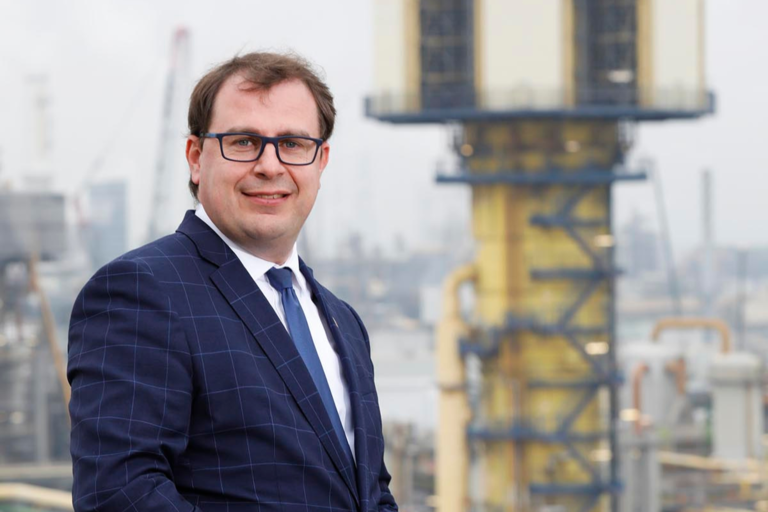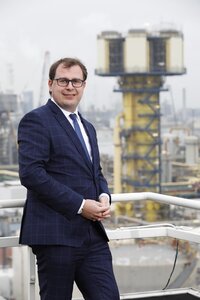
Port industry will play crucial role in energy transition
Climate change requires innovative solutions. From households, governments and industry. How can we reduce CO2 emissions is the central question? By committing fully to green hydrogen? On nuclear energy? Or is CO2 storage the egg of Columbus? Antwerp@C thinks the latter option is the most realistic in the short term. Frederik Pieters explains what the plans are.
The port industry is going to play a crucial role in the energy transition."
Antwerp@C is a consortium in which eight leading players from the Antwerp port area are joining forces. Air Liquide, Borealis, INEOS, ExxonMobil, Fluxys, Port of Antwerp, TotalEnergies and BASF, where Frederik Pieters is a corporate executive, signed a cooperation agreement in 2019. In it, the parties agreed to investigate the feasibility of a CO2 infrastructure for capturing and storing carbon dioxide in the port of Antwerp. 'We have the largest European integrated energy and chemical cluster,' says Pieters, raising the blinds in his office on Scheldelaan. 'Look, chemistry as far as the eye can see,' he says with some pride. 'So that offers unparalleled opportunities to create cross-company cooperation and prepare innovative CO2 reductions.'
Backbone
The port authority is not only the operator of the port, but also a community builder, says Pieters, who chairs Stakeholder Management, one of the working groups in the Antwerp@C project. "In the port of Antwerp we emit 18 million tons of CO2 every year. In the whole of Flanders it is 75 million tons. So roughly a quarter comes from us. Various sustainability projects have been running in the port for years. Such as pilot projects with hydrogen-powered tugs and shore power to replace diesel generators. But if you really want to achieve something substantial, you have to work together. That is why we now want to build a large pipeline together. A backbone where the entire industrial port community can let its captured CO2 flow in, after which it can be transported further'.
Great common interest
'Mind you,' warns Pieters, 'Antwerp@C only interferes with the common infrastructure. Companies must take care themselves to capture and purify CO2 in their processes. Only with purified CO2 that meets certain specifications can they connect to the central pipeline. In any case, the company that discharges carbon dioxide into the backbone from the end of that line is again responsible for its own transport, for example to an empty gas field in the North Sea.'
Working together sometimes has its challenges, Pieters realizes. 'Each company has its own strategy, interests and timeline. But all participants are willing to look at the great common interest and that is the construction of the infrastructure. In that infrastructure we also want to include a central plant in which we can liquefy the carbon dioxide. That way we can also transport the CO2 by ship. That can obviously be done well from this port.'
Hydrogen
Tata Steel recently announced that they are skipping the step of storing and using CO2 and are going to focus on hydrogen. Has Antwerp@C also examined this variant? Pieters: 'Certainly, all scenarios have been reviewed. Making steel is a different process from the chemical processes that take place here. If you want completely sustainable production, there has to be enough green hydrogen available in the short term. I doubt that. Here in Antwerp that is not yet the case. However, BASF in Ludwigshafen (DE), for example, is conducting research into turquoise hydrogen, through pyrolysis of methane. Besides hydrogen, this process produces solid carbon (not CO2), which we can use to make other products.'
Bridge technology
'CCS, CO2 storage, is a bridging technology. But how long this bridging will be needed is not clear in advance. A real temporary bridge was once installed in the center of Antwerp. That served forty years before it could be replaced by a tunnel. The bridge was a temporary way to get from A to B. And the time perspective is important. By 2030, we want to reduce CO2 emissions by 55%. That's as early as tomorrow, so to speak. We have now completed the feasibility studies of the backbone and are now in the engineering phase. In 2024 or 2025 we will have a modular concept. That means that in the next five years we should be able to capture, transport and store up to nine million tons of CO2 per year.'
Not new
Will it work? 'In Norway and in the US, there is already over thirty years of experience with storing carbon dioxide in the seabed. Capturing CO2 and transporting it through pipelines is also nothing new. Nor is liquefying the greenhouse gas. What is new is the scale on which it has to be done. And that we have to set up a complete chain for that. There are many factors that will influence the speed of the project: the different business strategies, the price of CO2 emissions and government subsidies.'
Large-scale and clustered
The chemical cluster in the Port of Antwerp makes a large number of basic chemicals needed for many consumer products. It would be good to make this better known to consumers, Pieters believes. 'Consumers are not sufficiently aware of this. In the future I can see a note on the packaging stating how much CO2 emissions were needed to make the product and that this partly determines the price. Just like the number of calories a particular food contains and that is stated on the back of the packaging.
Will we all be CO2 neutral by 2050? It will not be up to us. Roughly speaking, one third of emissions come from industry, one third from transport and one third from households. Here in industry, we can tackle things on a large scale and clustered together. In households and in the transportation sector, it is much more complicated. The port industry is going to play a crucial role in the energy transition.

